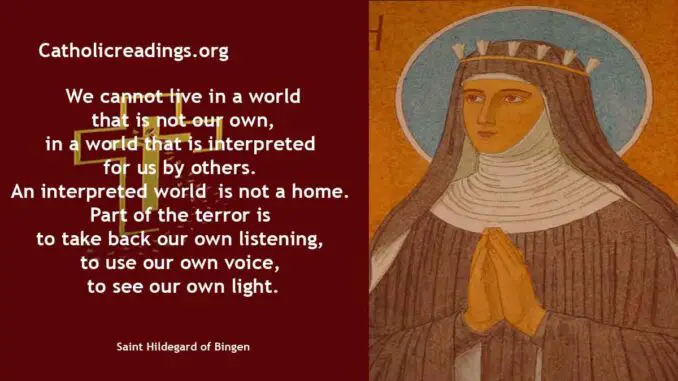St Hildegard of Bingen was a Benedictine abbess, writer, composer, and visionary.
She was born in 1098 AD in Bermersheim vor der Höhe, County Palatine of the Rhine, Germany.
She died on September 17 1179 at the age of 81 in Bingen am Rhein, Germany.
We celebrate her feast day on September 17 every year in the Catholic Church.
| Saint Hildegard of Bingen Biography | |
|---|---|
 |
|
| Date of Birth | 1098 AD |
| Place of Birth | Bermersheim vor der Höhe, County Palatine of the Rhine, Germany |
| Profession | Benedictine abbess, writer, composer, and visionary |
| Place of Work | Germany |
| Date of Death | September 17 1179 |
| Place of Death | Bingen am Rhein, Germany |
| Feast Day | September 17 |
| Beatification | by Pope John XXII on August 26 1326 |
| Canonization | by Pope Benedict XVI on May 10 2012 in Vatican City |
St Hildegard of Bingen Life History
St Hildegard of Bingen was also known as the Sibyl of the Rhine. Her father was Mechtild of Merxheim-Nahet and her mother was Hildebert of Bermersheim.
The family was of the lower nobility for they worked for the Count Meginhard of Sponheim.
She began to experience visions from an early age and said that she would see her soul going up beyond the clouds into the sky and spread itself out among different peoples.
Also, the light which she saw was immeasurable, and called it “the reflection of the living Light.”
Because of her mystic visions, Hildegard’s parents took her at a very young age to the Benedictine monastery at Disibodenberg, Rhineland-Palatinate, Germany to serve God.
The monastery was a community of women attached to the monastery of monks. In the monastery, she was placed in the care of Jutta who moulded and taught her many things like how to read and sing the Psalms. At the age of 18, she took her solemn vows and became a Benedictine nun.
When Jutta, her mentor died in 1136 AD, Hildegard was unanimously chosen by her fellow nuns to be their mother superior.
After a while, Abbot Kuno of Disibodenberg requested Hildegard not to move to a different location but she had a different idea. She wanted independence and an austere life for herself and her nuns.
Abbot Kuno objected but after a concerted effort, Hildegard was allowed to move out of the comfortable monastery to a temporary shelter in St. Rupertsberg monastery near Bingen in 1150 AD.
Fifteen years later, in 1165 Hildegard founded another permanent monastery at Eibingen opposite the bank of the Rhine and moved in with some of her nuns.
St Hildegard was instructed by her confessor to write down all the visions she had received right from the beginning. For ten years, she wrote down her Scivias (Know the Ways).
She was encouraged by Pope Eugene III to continue writing and thereafter she wrote the Liber Vitae Meritorum (“Book of the Rewards of Life”) and Liber Divinorum Operum (“Book of Divine Works”).
She also wrote musical compositions and short writings about physiology and medicine as well as many letters to the many people who visited her and sought her advice.
She also wrote commentaries on
- The Gospels,
- The Athanasian Creed
- Rule of St. Benedict
- Lives of the Saints
Unusual for a woman at that time, Hildegard made several journeys with many hardships to preach in churches and cathedrals and even in public squares.
Saint Hildegard of Bingen was embroiled in a controversy with the local diocesan authorities when she refused to allow the removal of the body of a man buried in the convent’s cemetery.
Before the man’s death, he had been excommunicated from the Church but had received his last sacraments before dying. This made Hildegard convinced that the man had been reconciled to the Church.
This refusal irked the Church officials and the Bishop of Mainz who consequently placed the convent under an interdict. The interdict would be removed later after Hildegard’s death.
St Hildegard of Bingen Death
Saint Hildegard of Bingen died on September 17 1179 at the monastery of Rupertsberg, Bingen. She was buried in the church’s cemetery.
Beatification
Saint Hildegard of Bingen was beatified by Pope John XXII on August 26 1326
Canonization
The canonization of Saint Hildegard of Bingen was delayed in the middle ages but she was always venerated as a saint over the ages. She was given equivalent canonization by Pope Benedict XVI on May 10 2012 in Vatican City.
On October 7 2012, Pope Benedict XVI named her a Doctor of the Church making her the fourth woman of 35 saints to be given that title by the Roman Catholic Church.
Saint Hildegard of Bingen Feast Day
We celebrate her feast day on September 17 every year in the Catholic Church
Saint Hildegard of Bingen Quote
We cannot live in a world that is not our own, in a world that is interpreted for us by others. An interpreted world is not a home.
Part of the terror is to take back our own listening, to use our own voice, to see our own light.
Related Links
Powered By SEO Experts
Follow @ReadingCatholic
